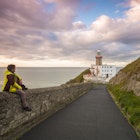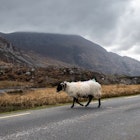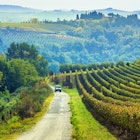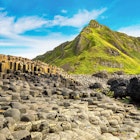The Emerald Isle is renowned for its spellbinding scenery. And while state-of-the-art main roads and motorways now link its cities and towns, there are some spectacular alternatives. Turn off the main thoroughfares to discover Ireland’s most scenic stretches of asphalt with these five picturesque routes.
Dublin to Portlaoise via the Wicklow Mountains (138km)
The bustling Irish capital of Dublin gives way to wild, remote countryside in the Wicklow Mountains. At the foot of the mountains, Powerscourt Waterfall (Ireland's highest), surrounded by beech, oak and pine trees, makes an idyllic picnic stop. Sweeping vistas over the surrounding blanket bog unfold from the Sally Gap mountain pass. The road winds through Wicklow Mountains National Park before descending to the leafy village of Laragh. Turning east here takes you past the precipitous, wooded Glendalough valley, sheltering Ireland's finest monastic settlement, founded in the 6th century by St Kevin. Many of its medieval buildings are still intact. The valley's two teal-blue lakes flank the road east towards the Midlands hub of Portlaoise.
Wexford to Waterford via Hook Head (95km)
Southwest of the Viking-founded town of Wexford, the Ring of Hook road circumnavigates the wind- and wave-swept Hook Peninsula. Its jagged southern tip, Hook Head, is capped by the black-and-white-striped, 13th-century Hook Lighthouse (the world’s oldest working lighthouse) and cloaked by sea spray. On the western side of the Hook Peninsula, it's a five-minute crossing by car ferry from Ballyhack, dominated by a 15th-century castle, to the thatched fishing village of Passage East. This storybook-pretty village neighbours the town of Crooke – in 1170, Strongbow (Robert FitzGilbert de Clare, earl of Pembroke) reputedly instructed his men to land ‘by Hook or by Crooke’ on his way to capture what's now the thriving port city of Waterford.
Killarney to Cork via the Beara Peninsula (320km)
On the doorstep of the glorious Killarney National Park, the lively town of Killarney is the jumping-off point for three captivating coastal drives, circling charming Dingle Peninsula to the north, the Iveragh Peninsula along the celebrated Ring of Kerry to the west, and the lesser-known Ring of Beara. Running around the rocky Beara Peninsula, the Ring of Beara takes in mountain-cradled lakes, ancient archaeological sites including Neolithic graves and mysterious standing stones, pastel-coloured pubs, and succulent seafood straight from its fishing fleet. Countless side roads corkscrew down to the fissured coast as you continue east of the Beara Peninsula to the urban hubbub of Ireland's second-largest city, Cork.
Galway to Westport via the Doolough Valley (160km)
North of the music-filled pubs and quaint painted shop fronts of Galway, the rugged, sheep-flecked Connemara region is crowned by Clifden, its 'capital'. Clifden's Sky Road loop is a scenic drive-within-a-scenic-drive – take the upper road for a dizzying panorama of the cragged coast. Connemara continues north past the glacier-carved fiord of Killary Harbour. One of Ireland’s most poignant roads sluices through the hauntingly beautiful Doolough Valley, with heath-covered hillsides and dark, silent lakes untouched by houses, cut turf or even the stone walls so prevalent in this area. In 1849, the valley was the site of a tragic Famine walk, when 400 people perished on the icy road in search of food and aid. Emerging from the narrow valley, the road parallels exposed, surf-pounded beaches to the Georgian jewel of Westport.
Belfast to Derry/Londonderry via the Causeway Coast (250km)
From Northern Ireland's vibrant capital Belfast (which, in 2012, will commemorate 100 years since the Titanic set out on its ill-fated journey) to its second-largest metropolis, the walled city of Derry/Londonderry, the Causeway Coastal Route traces the coast and retraces the outsized footsteps of mythical giant Finn McCool. The Giant's Causeway, incorporating 40,000 hexagonal basalt columns – built by McCool to fight his rival Benandonner in Scotland (or, more prosaically, formed by cooling lava 60 million years ago) – is a Unesco World Heritage-listed wonder. Other hit-the-brakes sights include the precariously swaying 20m-long Carrick-a-rede Rope Bridge to Carrick Island, the weathered ruins of medieval Dunluce Castle atop a basalt outcrop, cascading waterfalls in the oasis-like Glenariff Forest Park, and luminous limestone cliffs framing pristine White Rocks Beach.
Let the spirit of Ireland get under your skin and into your heart. For more information and great travel deals visit discoverireland.com
![]() Download our free PDF: 'Plan your dream trip to Ireland', an excerpt from Lonely Planet's Ireland travel guide
Download our free PDF: 'Plan your dream trip to Ireland', an excerpt from Lonely Planet's Ireland travel guide










